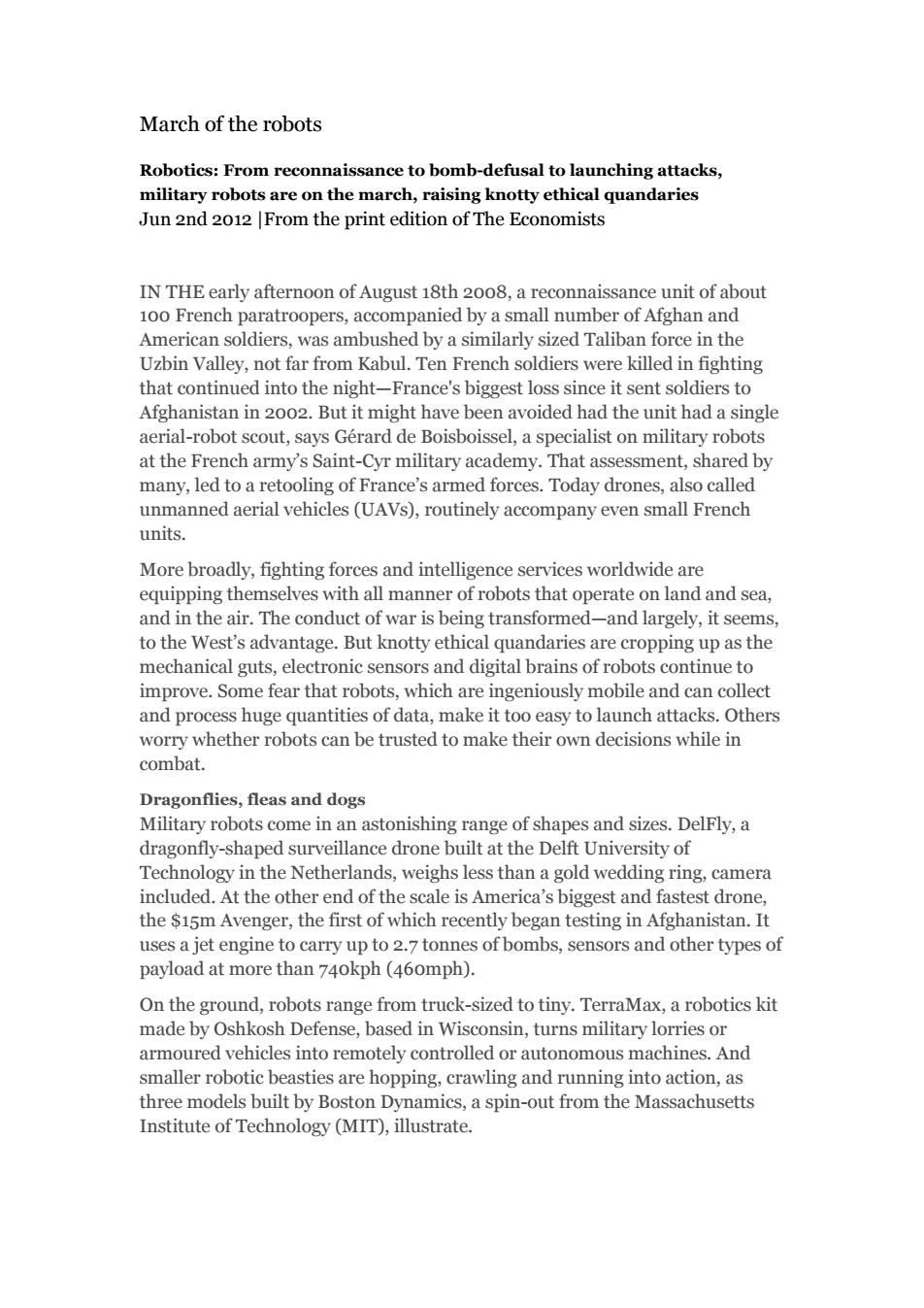正在加载图片...

March of the robots Robotics:From reconnaissance to bomb-defusal to launching attacks, military robots are on the march,raising knotty ethical quandaries Jun 2nd 2012 |From the print edition of The Economists IN THE early afternoon of August 18th 2008,a reconnaissance unit of about 100 French paratroopers,accompanied by a small number of Afghan and American soldiers,was ambushed by a similarly sized Taliban force in the Uzbin Valley,not far from Kabul.Ten French soldiers were killed in fighting that continued into the night-France's biggest loss since it sent soldiers to Afghanistan in 2002.But it might have been avoided had the unit had a single aerial-robot scout,says Gerard de Boisboissel,a specialist on military robots at the French army's Saint-Cyr military academy.That assessment,shared by many,led to a retooling of France's armed forces.Today drones,also called unmanned aerial vehicles(UAVs),routinely accompany even small French units. More broadly,fighting forces and intelligence services worldwide are equipping themselves with all manner of robots that operate on land and sea, and in the air.The conduct of war is being transformed-and largely,it seems, to the West's advantage.But knotty ethical quandaries are cropping up as the mechanical guts,electronic sensors and digital brains of robots continue to improve.Some fear that robots,which are ingeniously mobile and can collect and process huge quantities of data,make it too easy to launch attacks.Others worry whether robots can be trusted to make their own decisions while in combat. Dragonflies,fleas and dogs Military robots come in an astonishing range of shapes and sizes.DelFly,a dragonfly-shaped surveillance drone built at the Delft University of Technology in the Netherlands,weighs less than a gold wedding ring,camera included.At the other end of the scale is America's biggest and fastest drone, the $15m Avenger,the first of which recently began testing in Afghanistan.It uses a jet engine to carry up to 2.7 tonnes of bombs,sensors and other types of payload at more than 74okph (46omph). On the ground,robots range from truck-sized to tiny.TerraMax,a robotics kit made by Oshkosh Defense,based in Wisconsin,turns military lorries or armoured vehicles into remotely controlled or autonomous machines.And smaller robotic beasties are hopping,crawling and running into action,as three models built by Boston Dynamics,a spin-out from the Massachusetts Institute of Technology(MIT),illustrate.March of the robots Robotics: From reconnaissance to bomb-defusal to launching attacks, military robots are on the march, raising knotty ethical quandaries Jun 2nd 2012 |From the print edition of The Economists IN THE early afternoon of August 18th 2008, a reconnaissance unit of about 100 French paratroopers, accompanied by a small number of Afghan and American soldiers, was ambushed by a similarly sized Taliban force in the Uzbin Valley, not far from Kabul. Ten French soldiers were killed in fighting that continued into the night—France's biggest loss since it sent soldiers to Afghanistan in 2002. But it might have been avoided had the unit had a single aerial-robot scout, says Gérard de Boisboissel, a specialist on military robots at the French army’s Saint-Cyr military academy. That assessment, shared by many, led to a retooling of France’s armed forces. Today drones, also called unmanned aerial vehicles (UAVs), routinely accompany even small French units. More broadly, fighting forces and intelligence services worldwide are equipping themselves with all manner of robots that operate on land and sea, and in the air. The conduct of war is being transformed—and largely, it seems, to the West’s advantage. But knotty ethical quandaries are cropping up as the mechanical guts, electronic sensors and digital brains of robots continue to improve. Some fear that robots, which are ingeniously mobile and can collect and process huge quantities of data, make it too easy to launch attacks. Others worry whether robots can be trusted to make their own decisions while in combat. Dragonflies, fleas and dogs Military robots come in an astonishing range of shapes and sizes. DelFly, a dragonfly-shaped surveillance drone built at the Delft University of Technology in the Netherlands, weighs less than a gold wedding ring, camera included. At the other end of the scale is America’s biggest and fastest drone, the $15m Avenger, the first of which recently began testing in Afghanistan. It uses a jet engine to carry up to 2.7 tonnes of bombs, sensors and other types of payload at more than 740kph (460mph). On the ground, robots range from truck-sized to tiny. TerraMax, a robotics kit made by Oshkosh Defense, based in Wisconsin, turns military lorries or armoured vehicles into remotely controlled or autonomous machines. And smaller robotic beasties are hopping, crawling and running into action, as three models built by Boston Dynamics, a spin-out from the Massachusetts Institute of Technology (MIT), illustrate